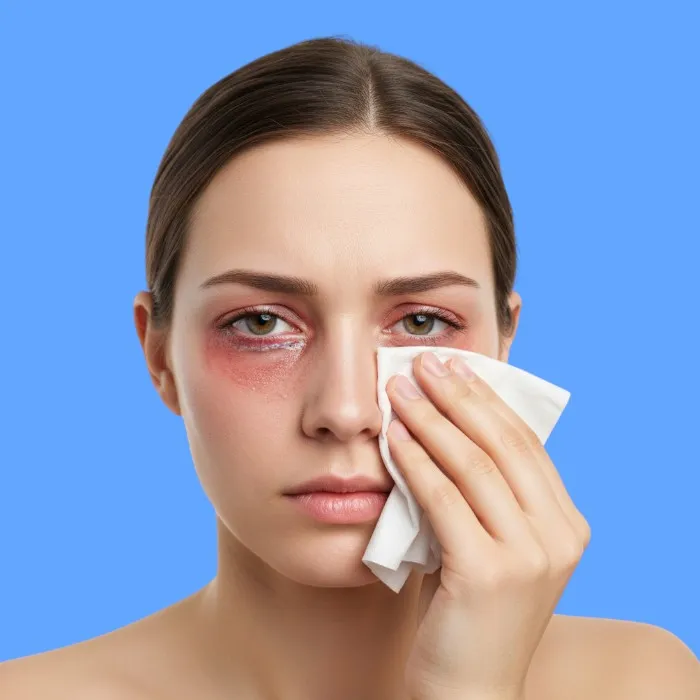what is conjunctivitis?
Conjunctivitis is a condition that affects the thin membrane covering the white part of the eye, known as the conjunctiva This inflammation makes the eye appear red and irritated, often accompanied by itching or burning sensations.
In many cases, the cause is a viral or bacterial infection, and sometimes it's due to an allergic reaction to substances like dust or cosmetics.
what are the causes of conjunctivitis?
The causes of conjunctivitis vary, and the most common ones include:
- Viral infections such as colds or flu.
- Bacterial infections caused by touching the eye with dirty hands.
- Seasonal allergies or reactions to dust or animals.
- Improper or prolonged use of contact lenses.
- Exposure to chemicals or smoke.
- Foreign objects entering the eye like sand or eyelashes.
- Sharing personal items like towels or makeup.
- Swimming in unclean or non-sterile water.
what are the common symptoms of conjunctivitis?

Symptoms of conjunctivitis are usually visible and include:
- Noticeable redness in the white part of the eye.
- Watery, yellow, or green discharge from the eye.
- Itching or burning sensation inside the eye.
- Mild swelling of the eyelid or around the eye.
- Increased sensitivity to light.
- Feeling like something is stuck in the eye.
- Continuous tearing without a clear reason.
- Eyelids sticking together upon waking due to discharge.
when should you see a doctor?
It is recommended to see a doctor immediately in the following cases to avoid complications:
- Symptoms persist for more than 3 days without improvement.
- Severe pain inside or around the eye.
- Sudden blurred or weak vision.
- Thick or foul-smelling discharge.
- Significant swelling in the eyelid or face.
- Other symptoms appear like fever or headache.
- If the patient is a child or infant.
- If there is a history of eye disease or previous surgery.
what are the treatment options for conjunctivitis?
Treatment depends on the cause of the inflammation, and the most common methods include:
- Using antibacterial eye drops for bacterial infections.
- Applying cold compresses to reduce irritation and itching.
- Avoiding allergens and using antihistamines.
- Gently cleaning the eye with warm sterile water.
- Temporarily stopping the use of contact lenses.
- Avoiding sharing personal items with others.
- Using moisturizing eye drops to reduce dryness.
- Resting and avoiding exposure to strong light.
can conjunctivitis be cured?
Yes, in most cases conjunctivitis can be cured within a few days.The duration depends on the cause, as viral cases often resolve on their own, while bacterial ones require treatment.
Maintaining hygiene and following proper treatment speeds up recovery and reduces the risk of spreading the infection.
what are the prevention tips for conjunctivitis?
To prevent conjunctivitis, it is advised to follow these tips:
- Wash hands regularly before touching the eyes.
- Avoid rubbing the eyes with hands.
- Do not share towels or makeup tools.
- Clean and disinfect contact lenses daily.
- Avoid swimming in unclean water.
- Use protective glasses when exposed to dust or chemicals.
- Ventilate rooms and avoid smoky enclosed spaces.
- See a doctor if any unusual symptoms appear.
what are the possible complications of conjunctivitis?
If treatment is neglected or delayed, complications may include:
- Infection spreading to deeper parts of the eye.
- Temporary or permanent vision impairment.
- Inflammation of the cornea or eyelid.
- Scarring on the surface of the eye.
- Easy transmission of infection to others.
- Recurrence of conjunctivitis.
- Chronic eye allergies.
- Negative impact on daily life quality.
frequently asked questions about conjunctivitis
Is conjunctivitis contagious?
Yes, especially if caused by a virus or bacteria.
Can I use eye drops without a prescription?
It's better to consult a doctor first.
Does conjunctivitis affect children?
Yes, it's common among them.
Can I wear contact lenses during infection?
No, you should stop until fully healed.
article summary
Conjunctivitis is a common condition that affects the eye, causing redness, irritation, and uncomfortable symptoms It is often caused by infection or allergy and can be treated easily if detected early.
Prevention starts with personal hygiene and avoiding infection sources, and medical follow-up is essential in severe cases.